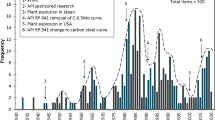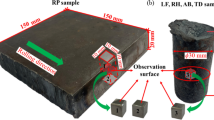Abstract
In this work, the surface films formed on an X52 pipeline steel in H2S-containing environments with various pH values and H2S concentrations were characterized by surface analysis techniques and electrochemical impedance spectroscopy. A stoichiometric FeS film is formed during H2S corrosion of the steel. At low pH (e.g., 3.5) and low H2S concentration (e.g., 0.2 mmol/L), the film is primarily crystalline FeS. When the H2S concentration increases to 2 and 20 mmol/L, mackinawite is also formed. At high pH of 5.5 and low H2S concentration of 0.2 mmol/L, the film is amorphous FeS. With the increase in the H2S concentration to 2 and 20 mmol/L, the film changes to crystalline FeS and the mixture of crystalline FeS and mackinawite, respectively. In low-pH solution (pH 3.5), the compact, crystalline FeS is more protective for steel corrosion compared to mackinawite. As the H2S concentration increases, the corrosion is increased. At high pH of 5.5, when the H2S concentration is 0.2 mmol/L, the low corrosivity of the environment causes production of amorphous FeS only. As the H2S concentration is increased, a thick film is generated, reducing somewhat the steel corrosion.











Similar content being viewed by others
References
H.B. Xue and Y.F. Cheng, Hydrogen Permeation and Electrochemical Corrosion Behavior of the X80 Pipeline Steel Weld, J. Mater. Eng. Perform., 2013, 22, p 170–175
T. Hara, H. Asahi, and H. Ogawa, Conditions of Hydrogen-Induced Corrosion Occurrence of X65 Grade Line Pipe Steels in Sour Environments, Corrosion, 2004, 60, p 1113–1121
F. Huang, X.G. Li, J. Liu, Y.M. Qu, and C.W. Du, Effects of Alloying Elements, Microstructure, and Inclusions on Hydrogen Induced Cracking of X120 Pipeline Steel in Wet H2S Sour Environment, Mater. Corros., 2012, 63, p 59–66
M.A. Lucio-Garcia, J.G. Gonzalez-Rodriguez, M. Casales, L. Martinez, J.G. Chacon-Nava, M.A. Neri-Flores, and A. Martinez-Villafane, Effect of Heat Treatment on H2S Corrosion of a Micro-alloyed C-Mn Steel, Corros. Sci., 2009, 51, p 2380–2386
C. Zhang and Y.F. Cheng, Synergistic Effects of Hydrogen and Stress on Corrosion of X100 Pipeline Steel in a Near-Neutral pH Solution, J. Mater. Eng. Perform., 2010, 19, p 1284–1289
C.S. Zhou, S.Q. Zheng, C.F. Chen, and G.W. Lu, The Effect of the Partial Pressure of H2S on the Permeation of Hydrogen in Low Carbon Pipeline Steel, Corros. Sci., 2013, 67, p 184–192
A.J. McEvily and I. Le May, Hydrogen-Assisted Cracking, Mater. Charact., 1991, 26, p 253–268
R.A. Carneiro, R.C. Ratnapuli, and V.F.C. Lins, The Influence of Chemical Composition and Microstructure of API, Linepipe Steels on Hydrogen Induced Cracking and Sulfide Stress Corrosion Cracking, Mater. Sci. Eng. A, 2003, 357, p 104–110
A. Kawashima, K. Hashimoto, and S. Shimoaira, Hydrogen Electrode Reaction and Hydrogen Embrittlement of Mild Steel in Hydrogen Sulfide Solutions, Corrosion, 1976, 32, p 321–331
A.H.S. Bueno, E.D. Moreira, P. Siqueira, and J.A.C.P. Gomes, Effect of Cathodic Potential on Hydrogen Permeation of API, Grade Steels in Modified NS4 Solution, Mater. Sci. Eng. A, 2014, 597, p 117–121
F. Huang, X.G. Li, J. Liu, Y.M. Qu, J. Jia, and C.W. Du, Hydrogen Induced Cracking Susceptibility and Hydrogen Trapping Efficiency of Different Microstructure X80 Pipeline Steel, J. Mater. Sci., 2011, 46, p 715–722
F. Huang, J. Liu, Z.J. Deng, J.H. Cheng, Z.H. Lu, and X.G. Li, Effect of Microstructure and Inclusions on Hydrogen Induced Cracking Susceptibility and Hydrogen Trapping Efficiency of X120 Pipeline Steel, Mater. Sci. Eng. A, 2010, 52, p 6997–7001
S.J. Kim, J.H. Park, and K.Y. Kim, Effect of Microstructure on Sulfide Scale Formation and Corrosion Behavior of Pressure Vessel Steel in Sour Environment, Mater. Charact., 2016, 111, p 14–20
H. Castaneda, E. Sosa, and M.A. Espinosa-Medina, Film Properties and Stability Influence on Impedance Distribution During the Dissolution Process of Low-Carbon Steel Exposed to Modified Alkaline Sour Environment, Corros. Sci., 2009, 51, p 799–806
D.W. Shoesmith, P. Taylor, M.G. Bailey, and D.G.O. Wen, The Formation of Ferrous Monosulfide Polymorphs During the Corrosion of Iron by Aqueous Hydrogen Sulfide at 21-Degrees-C, J. Electrochem. Soc., 1980, 127, p 1007–1015
J. Ning, Y. Zheng, D. Young, B. Brown, and S. Nesic, Thermodynamic Study of Hydrogen Sulfide Corrosion of Mild Steel, Corrosion, 2014, 70, p 375–389
D.R. Morris, L.P. Sampaleanu, and D.N. Veysey, The Corrosion of Steel by Aqueous Solutions of Hydrogen Sulfide, J. Electrochem. Soc., 1980, 127, p 122–135
Z.A. Iofa, V.V. Batrakov, and Cho-Ngok-Ba, Influence of Anion Adsorption on the Action of Inhibitors on the Acid Corrosion of Iron and Cobalt, Electrochim. Acta, 1964, 9, p 1645–1653
W. Sun and S. Nesic, A Mechanistic Model of Uniform Hydrogen Sulfide/Carbon Dioxide Corrosion of Mild Steel, Corrosion, 2009, 65, p 291–307
X.L. Cheng, H.Y. Ma, J.P. Zhang, X. Chen, S.H. Chen, and H.Q. Yang, Corrosion of Iron in Acid Solutions With hydrogen Sulfide, Corrosion, 1998, 54, p 369–376
C.F. Dong, K. Xiao, X.G. Li, and Y.F. Cheng, Galvanic Corrosion of a Carbon Steel-Stainless Steel Couple in Sulfide Solutions, J. Mater. Eng. Perform., 2011, 20, p 1631–1637
Z.F. Yin, W.Z. Zhao, Z.Q. Bai, Y.R. Feng, and W.J. Zhou, Corrosion Behavior of SM 80SS Tube Steel in Stimulant Solution Containing H2S and CO2, Electrochim. Acta, 2008, 53, p 3690–3700
S. Arzola, J. Mendoza-Flores, R. Duran-Romero, and J. Genesca, Electrochemical Behavior of API, X70 Steel in Hydrogen Sulfide-Containing Solutions, Corrosion, 2006, 62, p 433–443
H. Vedage, T.A. Ramanarayanan, J.D. Munford, and S.N. Smith, Electrochemical Growth of Iron Sulfide Films in H2S-Saturated Chloride Media, Corrosion, 1993, 49, p 114–121
H. Her-Hsiung, T. Wen-Ta, and L. Ju-Tung, Electrochemical Behavior of the Simulated Heat-Affected Zone of A516 Carbon Steel in H2S Solution, Electrochim. Acta, 1996, 41, p 1191–1199
T.A. Ramanarayanan and S.N. Smith, Corrosion of Iron in Gaseous Environments and in Gas-Saturated Aqueous Environments, Corrosion, 1990, 46, p 66–74
N. Sridhar, D.S. Dunn, A.M. Anderko, M.M. Lencka, and H.U. Schutt, Effects of Water and Gas Compositions on the Internal Corrosion of Gas Pipelines—Modeling and Experimental Studies, Corrosion, 2001, 57, p 221–235
Y. Dong, F. Huang, J.J. Wang, H.J. Cheng, and Y. Wang, Evolution of Corrosion Films on X52 Pipeline Steel in Saturated H2S-Cl− Solution, Corros. Prot., 2015, 36, p 1–6
M.A. Veloz and I. González, Electrochemical Study of Carbon Steel Corrosion in Buffered Acetic Acid Solutions with Chlorides and H2S, Electrochim. Acta, 2002, 48, p 135–144
A. Davoodi, M. Pakshir, M. Babaiee, and G.R. Ebrahimi, A Comparative H2S Corrosion Study of 304L and 316L Stainless Steels in Acidic Media, Corros. Sci., 2011, 53, p 399–408
H. Ma, X.L. Cheng, G.Q. Li, S.H. Chen, Z.L. Quan, S.Y. Zhao, and L. Niu, The Influence of Hydrogen Sulfide on Corrosion of Iron Under Different Conditions, Corros. Sci., 2000, 42, p 1669–1683
Z.F. Yin, W.Z. Zhao, W.Y. Lai, and X.H. Zhao, Electrochemical Behaviour of Ni-Base Alloys Exposed Under Oil/Gas Field Environments, Corros. Sci., 2009, 51, p 1702–1706
M.B. McNeil and B.J. Little, Technical Note: Mackinawite Formation During Microbial Corrosion, Corrosion, 1990, 46, p 599–600
K.J. Wu, H.Y. Ma, S.H. Chen, Z.Y. Xu, and A.F. Sui, General Equivalent Circuits for Faradaic Electrode Processes Under Electrochemical Reaction Control, J. Electrochem. Soc., 1999, 146, p 1847–1856
Acknowledgments
This work was supported by the National Natural Science Foundation of China (No: 51201119).
Author information
Authors and Affiliations
Corresponding author
Rights and permissions
About this article
Cite this article
Huang, F., Cheng, P., Dong, Y.Y. et al. Characterization of Surface Films Formed During Corrosion of a Pipeline Steel in H2S Environments. J. of Materi Eng and Perform 26, 828–836 (2017). https://doi.org/10.1007/s11665-017-2510-4
Received:
Revised:
Published:
Issue Date:
DOI: https://doi.org/10.1007/s11665-017-2510-4




